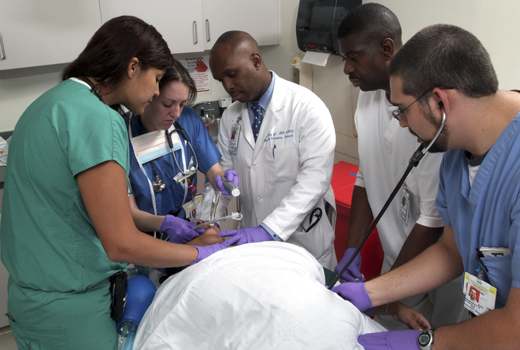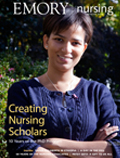Interdisciplinary class addresses national issue of medical errors
Students from the health science professions learned key lessons in how to reduce medical errors and save lives during the first and largest interdisciplinary class of its kind at Emory.
Last fall, 450 students representing nursing, medicine, physician assistant, physical therapy, and medical imaging took part in the Interprofessional Communication Class organized by faculty from Emory’s Woodruff Health Sciences Center and Grady Health System. The class was a model of teamwork, involving 45 interdisciplinary groups of 10 students. More than 80 faculty members from Emory and Grady worked in pairs to lead the groups of students in discussion and role play following a lecture stressing that clear communication among health care team members can reduce medical errors.
“We’re not the only university to offer this type of class, but we are unique in the number of disciplines and the number of students involved,” says emergency medicine physician Douglas Ander, who directs the Emory Center for Experiential Learning in the School of Medicine.
The class is an extension of the Interprofessional Team Training Day launched by the schools of nursing and medicine in 2008. In that class, more than 200 senior nursing and third-year medical students worked together to run an emergency code on patient mannequins in both schools. The class, held again in early 2009 with Georgia Tech as a partner, has proven successful.
“Students told us they wanted to have more opportunities to learn together earlier in their education,” says Marsha Lewis, associate dean for education in the School of Nursing. As a result, Emory and Georgia Tech faculty began to develop the Interprofessional Communication Class for first-year nursing and medical students. As word about the class spread, allied health faculty and students joined the mix, as did master’s students in nursing. The result was Emory’s first large-scale effort to provide a common training experience for students from different health professions programs.
The need for the class is compelling, given the number of medical errors that result from poor communication. “The root cause of all sentinel events, as reported by the Joint Commission from 1995 to 2007, is poor communication,” says Bethany Robertson, clinical assistant professor of nursing and one of the class planners. “Clear communication lies at the heart of effective and efficient teamwork and is a critical skill that crosses all health professions disciplines.”
Student feedback about the class has been positive, especially from nursing students immersed in clinical learning at the bedside. “They found the class beneficial in developing relationships and understanding the need for effective communication patterns,” she adds.
This fall, the same group of interdisciplinary students will meet again for a class on role identity, followed by a class on team identity in spring 2011. “We chose these concepts because they are the building blocks of teamwork,” says Robertson. “Our goal is to provide the basics so that Emory graduates can continue their lifelong journey of learning and perfecting teamwork as they enter the practice arena. ”—Pam Auchmutey



